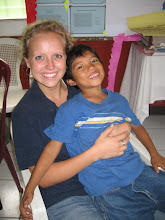I keep postdating my blogs, trying to trick you that I've been writing bimonthly, but I'm going to stop that right now. You're all smart people and you deserve to know the truth: I'm a lousy blogger.
Ok, moving on...
I joke that I've become an expert in babies since coming to Nica. I've become quite good at judging whether to ask how many years or how many months the baby has (there is no direct Spanish translation for "how old are you?"). I can coo in Spanish and in English. I know that the little rock bracelets are to ward off the evil eye and that if a baby has the hiccups, all you need is a piece of red thread to put on their little foreheads. It may not all make sense, but it's life here and I love it.
Two babies in particular have stolen my heart for their own precious reasons. The first is brand-new. As I write, Tamara Murillo "has" 15 days and is the newest addition to one of the largest families in Cedro Galan, our rural community. Her grandmother has twelve children and Xiomara, Tamara's mom, is her youngest. Mama Murillo can't tell you how many grandchildren she has but I'm guessing she's rapidly approaching thirty (if she hasn't passed it already). Tessa and I visited all three generations of Murillo women on Friday, first to see how the new mom was faring (she's tired, but glowing), but also to introduce ourselves to our new teeny friend. Her feet are the size of my finger and she swam in the white dress her mom insisted on her wearing. We had our own little photo shoot in her family's dirt-floored house as these are the first pictures anyone has taken of the baby. She has so much promise... I can't wait to visit in the years ahead to see her running around dressed in her school uniform, her hair in pigtails.
The second baby is Manuel Antonio, one of our children in Chureca's child sponsorship program. He doesn't talk to gringos yet, but he has such dark, deep eyes that I know a lot of thoughts are churning in that little head. When he entered the program last August, he couldn't sit up on his own even though he was a year and a half old (he recently turned two). Now, with our program's help, he's gained enough strength not only to sit, but also to walk. However, last week his mom (who's younger than me) told me that because the people in Chureca are on strike (see my most recent post on the child sponsorship blog), she's been having a hard time finding the money to feed him and his little brother Ignacio. I'm scared that if the strike continues, the (literal) baby steps we've made with him will not be enough.

Right now I'm reading a great book called
Cold Tangerines. The author believes that Jesus came to earth as a baby because "babies make us believe in the possibility and power of the future." Now, after just celebrating what that baby did as a grown man, I'd like to believe that, too, although sometimes it's hard to see through all the dirt and the smoke.
 I spent two mornings with him and his mother driving from Chureca to Mascota, one of Managua's children's hospitals. There we waited in lines, got lost in corridors and argued with parking attendants only to walk away with an appointment with an ophthalmologist... in June. You see, in Nicaragua you wait in line just to get an appointment, where you get to wait in line again. By the end of the second day, I was exhausted, frustrated and disappointed, apologizing to Natan's mom because we weren't able to see a doctor. Instead of complaining or commiserating, she thanked me.
I spent two mornings with him and his mother driving from Chureca to Mascota, one of Managua's children's hospitals. There we waited in lines, got lost in corridors and argued with parking attendants only to walk away with an appointment with an ophthalmologist... in June. You see, in Nicaragua you wait in line just to get an appointment, where you get to wait in line again. By the end of the second day, I was exhausted, frustrated and disappointed, apologizing to Natan's mom because we weren't able to see a doctor. Instead of complaining or commiserating, she thanked me. 

